During WWII, fighter and bomber aircraft were crucial to the success of any one side in the conflict. With reliable models and new innovations, the U.S. Navy left a proud legacy on the seas and in the skies.
Although the Navy is well-known for its ships and submarines, throughout the last century and this it has maintained a highly effective, state-of-the-art fleet of aircraft, with as many planes as any situation requires. During WWII, the pilots of the U.S. Navy played a crucial role in the Allied victory. These are some of the aircraft that helped them win.
TBM/TBF Avenger

TBM Avengers during flight operations
Year: 1942
Wingspan: 54ft 2in
Ceiling: 30,100ft
Role: Torpedo bomber
Speed: 275mph
Range: 1,000mi
Armament: 3 x .50cal M2 Browning machine guns, 1 x .30cal M1919 Browning machine gun, up to 2,000lbs of bombs, or 1 x 2,000lb Mark 13 torpedo
Nicknamed the “turkey” due to its ungainly size and massive bomb bay, the Avenger quickly sealed its place as one of the deadliest torpedo bombers of WWII. With the TBM produced by General Motors and the TBF produced by Grumman, the aircraft featured a folding wing design to help conserve space, allowing it to operate from even the smaller escort carriers.
Though initially meeting with disaster at the Battle of Midway, the Avenger soon proved itself unmatched in carrier vs. carrier combat. With a capacity for either four 500lb bombs or a single 2,000lb one, it became an essential force in helping the Allies win the war.
F4u Corsair
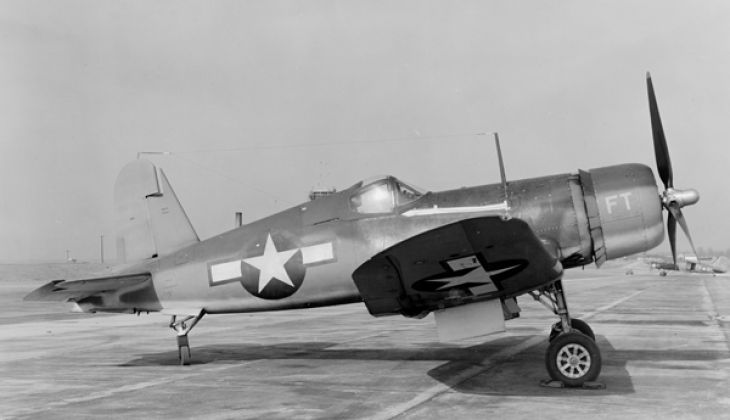
Vought F4U-1 "Cosair" at NAS Patuxent River, Maryland, 27 January 1944
Year: 1942
Role: Carrier-based fighter-bomber
Wingspan: 41ft
Speed: 446mph
Ceiling: 41,500ft
Range: 1,005mi
Armament: 6 x .5cal M2 Browning machine guns or 4 x .79cal AN/M3 cannon
One of the fiercest fighter aircraft in WWII, the F4U Corsair soon became a recognized and familiar silhouette in the skies. With a distinct, oversized propeller and bent gull wings, the Corsair was unmistakable. Additionally, the air intakes mounted on the wings caused a noticeable whistling sound, adding to its reputation and causing Japanese ground troops to nickname it “Whistling Death”, a name that would prove to be deadly accurate.
During WWII, Allied fighters earned a formidable kill ratio of 11:1, impressive by any standards. After the end of WWII, the Corsair saw action again in the Korean War before finally being retired in 1953.
SBD Dauntless

Douglas SDB-4 Dauntless
Year: 1940
Role: Dive/scout bomber
Wingspan: 41ft 6in
Speed: 255mph
Ceiling: 25,530ft
Range: 1,115mi
Armament: 2 x .50cal M2 Browning machine guns, 2 x .3cal Browning machine gun 2,250lbs of bombs
Allowing pilots to dive at a remarkable 80 degree angle, the SBD Dauntless was a key aircraft during WWII. She became the crucial element during the Battle of Midway, delivering the final strikes to all four Japanese carriers.
Although she was an older model before the war even began, and she would later be replaced with the SB2C Helldiver, she proved her worth time and time again. Despite quickly earning the affectionate nickname of “Slow But Deadly” as a play on her designation, and she gained prestige and respect by the war’s end.
F6F HELLCAT FIGHTER
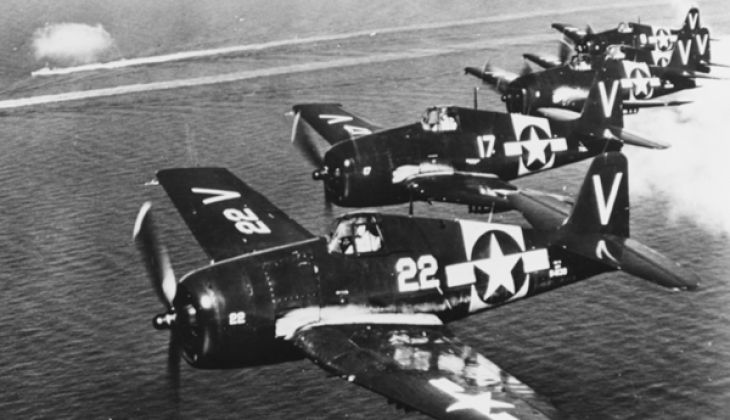
In formation, during the later 1940s. Plane in the forground is BuNo 94139, an F6F-5.
Year: 1943
Role: Carrier-based fighter
Wingspan: 42ft 10in
Speed: 391mph
Ceiling: 37,300ft
Range: 944mi
Armament: 6 x .50cal M2 Browning machine guns or 2 x .79cal AN/M2 cannon and 4 x .50cal Browning machine guns; up to 4,000lbs of bombs
The F6F Hellcat was nicknamed the “Aluminum Tank” due to her incredible ability to absorb damage and keep on flying. The successor to the F4F Wildcat, the Hellcat soon established herself as a sturdy and deadly aircraft in her own right.
Featuring foldable wings for storage efficiency and a standard 3 guns per wing, the Hellcat would be credited with destroying over 5,000 enemy planes during her service, more than any other Allied aircraft, making her essential to the outcome of WWII.
SNJ TEXAN TRAINER
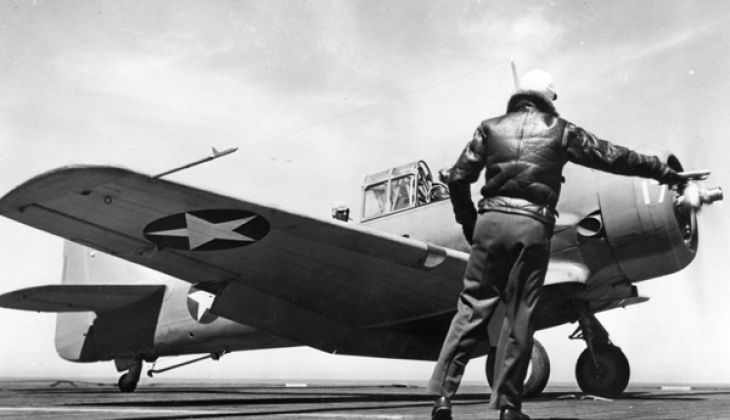
Launching a SNJ trainer, 26 April 1943, off the USS WOLVERINE (IX-64)
Year: 1935
Role: Training aircraft
Wingspan: 41ft
Speed: 209mph
Ceiling: 24,199ft
Range: 750mi
Armament: Provision for up to 3 x .30cal machine guns
Developed as a training aircraft in the mid-1930s, the single-engine Texan Trainer would become known throughout history for her durability and reliability. She featured two seats, one for a trainer and one for a student, and became instrumental in preparing young pilots for battle. Though primarily known as the SNJ Texan Trainer, she was also designated as the AT-6 by the U.S. Army Air Corps, and the Harvard by the British Commonwealth.
Widely used during WWII itself, the Texan Trainer would continue use long after the war came to a close. Officially retired in 1995, she remains a favorite of air shows and aircraft enthusiasts to this day.
SB2U-3 VINDICATOR
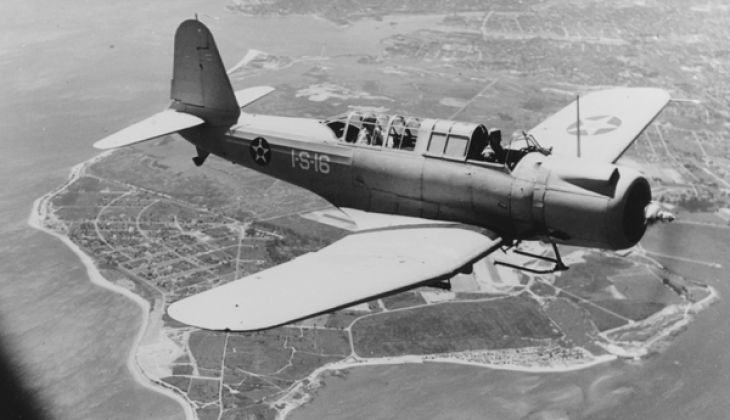
Vought SB2U-3 "Vindicator" of marine Scouting Squadron One, in flight, 7 June 1941
Year: 1937
Role: Dive/scout bomber
Wingspan: 41ft
Speed: 251mph
Ceiling: 27,500ft
Range: 630mi
Armament: 1 x .30cal M1919 Browning machine gun, 1 x .30cal machine gun, 1 x 1,000lb bomb
The SB2U Vindicator became the first ever monoplane in the role of dive-bombing aircraft. The late 1930s marked the major transition of naval aviation from biplanes to monoplanes, marking a dramatic difference in speed and efficiency. The Vindicator featured a single set of wings instead of the double set found on biplanes, as well as retractable conventional tailwheel landing gear.
Though only 260 units were produced, and she was entirely obsolete by the beginning of WWII, the Vindicator still shines as a forerunner of modern aviation and progress, even today.
FM/F4F wildcat
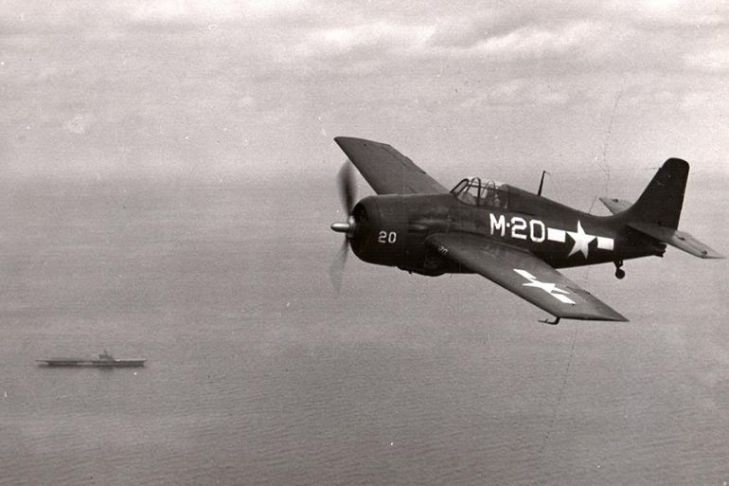
Wildcat photographed above USS Sable
Year: 1940
Role: Fighter aircraft
Wingspan: 38ft
Speed: 331mph
Ceiling: 34,698ft
Range: 900mi
Armament: 4 x .50cal AN/M2 Browning machine guns, 2 x 100lb bombs, or 2 x 58gal droptanks
Although quickly outclassed by more modern aircraft in her own lifetime, the F4F Wildcat proved herself to be a sturdy, reliable, and effective fighter in her own right. She boasted a cockpit placed high on her short, barrel-shaped fuselage, lending her a distinct and stubby appearance. Additionally, her wings could be folded for efficient storage. Wildcats continued to be manufactured through the end of the war, showing that she was more than capable of holding her own in combat.
The Wildcat would later give way to the sleeker and faster F6F Hellcat, introduced in 1943. But while she served in the Navy, the Wildcat was a key cornerstone in America’s victory in WWII.
DRONES/TDNS

WWII drones lined up on USS Sable
Year: 1942
Role: Assault drone
Wingspan: 48ft
Speed: 145mph
Armament: 1 x 2,000lb bomb or aerial torpedo
In the early 1940s, the Navy began developing the idea of producing remotely guided aircraft with the intent of carrying bombs or torpedoes from carriers. With the advent of radar and television, these ideas suddenly began to seem feasible in ways they never were before. The simplified aircraft were almost entirely made from wood, and featured fixed tricycle landing gear.
Although the experimental drones met with some success, the Navy ultimately decided they were too costly and complicated for continued use. However, the TDNs are recognized with paving the way for today’s drones and remote aircraft, setting the stage for the modern technology to come.